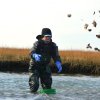In the past few weeks, an exceptional number of jellyfish have been observed in and around Lewes and Rehoboth, especially the red-orange lion’s mane. This jellyfish is one of the largest jellyfish in our local waters, and elsewhere grows to be the largest jellyfish in the world. Fortunately, they tend to be much smaller in our Mid-Atlantic waters; unfortunately, they are more abundant and their sting just as painful.
So what are jellyfish? Jellyfish are the dominant body form, the adult phase of the life cycle of these animals. Like most animals, they feed, grow and reproduce. Lion’s mane jellyfish feed on many different kinds of animals, including other jellyfish and small fish, using their tentacles to capture food and transport their prey to their mouth, located under the lobed bell. The mouth is surrounded by four frilly arms, which help capture and eat prey. The prey are paralyzed by toxins injected into them by stinging structures called nematocysts in specialized cells found mostly in the tentacles and in the oral arms, and also in the bell. Each nematocyst is a capsule with a coiled tube that expands when touched, ejecting a long, barbed, hollow thread connected to a poison sac. The tip of the barbed thread enters the body of the prey and the toxin does the rest.
When people encounter a jellyfish, the process is the same, usually causing painful welts and rashes. Although applying vinegar to the affected area generally stops any unexploded nematocysts from firing, vinegar has the opposite effect on lion’s mane and sea nettle nematocysts, causing them to discharge. The recommended first-aid treatment is to rinse the affected area with sea water and remove any tentacles with tweezers, and to apply baking soda (50% slurry) and ice.
Why are there so many? Jellyfish congregate when the water temperature is warm and food is plentiful. The orangish-colored creamy area in the clear bell is where the gametes are produced. Although nearly identical in appearance, there are both male and female jellyfish. When jellyfish spawn, the eggs in the females are fertilized. The fertilized eggs pass out of the mouth and lodge in the female jellyfish’s oral arms, where they start to develop into tiny, free-swimming, worm-like animals called planulae. After a few days, these settle down on the bottom of the bay or ocean and become small, inconspicuous, tentacled animals called polyps. Polyps are usually attached to rocks or other hard surfaces. The polyps’ bodies are upside-down compared to that of the jellyfish; the mouth is on top, surrounded by tentacles that capture animals to eat.
During the summer and fall, a well-fed polyp can make many more polyps by budding off clones of itself. With the start of winter, the polyps begin to produce the adult stage of jellyfish by splitting their upper bodies into numerous small frisbee-like disks, which break away and enter the water column (a process called strobilation). The young jellyfish produced by the polyps will become adult jellyfish by spring or summer. The whole life cycle, from fertilized egg to polyp to adult jellyfish, takes place in one year for the lion’s mane. Polyps, however, can continue to live for several years and produce young jellyfish each year. The jellyfish are abundant now because water temperatures, currents and food availability were right for their survival and growth throughout their annual life cycle stages, from gametes to polyps to jellyfish. Unfortunately, abundant jellyfish will produce abundant polyps and more jellyfish, if the conditions are right.





















































